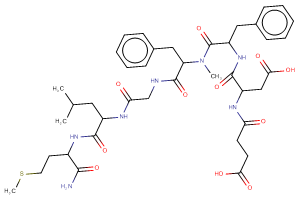
Senktide
CAS No. 106128-89-6
Senktide( —— )
Catalog No. M21173 CAS No. 106128-89-6
Senktide is an?agonist of tachykinin NK3 receptor.
Purity : >98% (HPLC)
 COA
COA
 Datasheet
Datasheet
 HNMR
HNMR
 HPLC
HPLC
 MSDS
MSDS
 Handing Instructions
Handing Instructions
| Size | Price / USD | Stock | Quantity |
| 5MG | 119 | Get Quote |


|
| 10MG | 177 | Get Quote |


|
| 100MG | Get Quote | Get Quote |


|
| 200MG | Get Quote | Get Quote |


|
| 500MG | Get Quote | Get Quote |


|
| 1G | Get Quote | Get Quote |


|
Biological Information
-
Product NameSenktide
-
NoteResearch use only, not for human use.
-
Brief DescriptionSenktide is an?agonist of tachykinin NK3 receptor.
-
DescriptionSenktide is an?agonist of tachykinin NK3 receptor.
-
In Vitro——
-
In Vivo——
-
Synonyms——
-
PathwayGPCR/G Protein
-
TargetNeurokinin Receptor
-
RecptorNK3
-
Research Area——
-
Indication——
Chemical Information
-
CAS Number106128-89-6
-
Formula Weight842
-
Molecular FormulaC40H55N7O11S
-
Purity>98% (HPLC)
-
SolubilityDMSO:50 mg/mL (59.38 mM; Need ultrasonic)
-
SMILESCSCCC(NC(=O)C(CC(C)C)NC(=O)CNC(=O)C(Cc1ccccc1)N(C)C(=O)C(Cc1ccccc1)NC(=O)C(CC(=O)O)NC(=O)CCC(=O)O)C(N)=O
-
Chemical Name(5S8S14S17S20S)-1417-dibenzyl-5-carbamoyl-20-(carboxymethyl)-8-isobutyl-15-methyl-71013161922-hexaoxo-2-thia-6912151821-hexaazapentacosan-25-oic acid
Shipping & Storage Information
-
Storage(-20℃)
-
ShippingWith Ice Pack
-
Stability≥ 2 years
Reference
1.Keegan KD et al. The selective NK3 receptor agonist senktide excites a subpopulation of dopamine-sensitiveneurones in the rat substantia nigra pars compacta in vitro. Br J Pharmacol. 1992 Jan;105(1):3-5.
molnova catalog



related products
-
R 396
R 396 is a linear hexapeptide and is also an NK-2 tachykinin receptor antagonist.
-
Ibodutant
A potent and selective linear tachykinin NK2 receptor antagonist with pKb of 9.3; displays >1,000-fold selectivity over NK1 and NK3 (pKb<6).
-
Serlopitant
Serlopitant (VPD-737, MK-0594) is a potent, selective substance P/neurokinin 1 (NK1) receptor for treating chronic pruritus.



 Cart
Cart
 sales@molnova.com
sales@molnova.com


